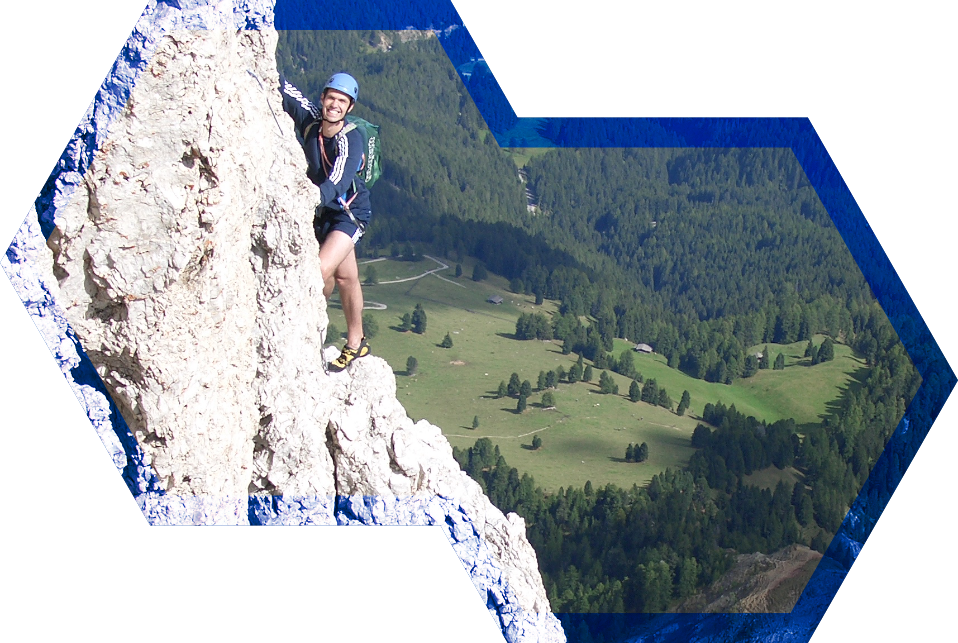Having come into this world just a slingshot south of the Dolomites, the most beautiful mountains in the world, I grew up with an intense passion for mountaineering. Since a young age I went walking, hiking, trekking, biking, running, scrambling in the hills close to home and the peaks just a short drive behind them.
At the age of 28 I decided to take an indoor climbing course to further pursue my passion. I learned how to practice this wonderful sport safely, then I spent that summer practicing in outdoor crags on single-pitch climbs. This was just 6 months before leaving Italy for good and moving to the UK, where they call ordinary hills “mountains”. Just for your reference, I now live in the Netherlands, where one needs to drive to the sea to go uphill…
Before I go any further, I must point out that what outsiders call “rock climbing” actually consists of at least four distinct disciplines with varying degrees of risk attached to them. In order of risk factor, lowest to highest, they are:
– Bouldering – Very short climbs, where a fall is normally harmless; the only safety gear is a crash pad (it’s what you see me doing on the picture at the top of this article)
– Sport climbing – Long climbs, where a fall could be fatal; climbers use permanent anchors that are bolted onto the wall for protection (the most common form of rock climbing and my favourite)
– Trad climbing – Long climbs, where a fall could be fatal; climbers manually fix temporary anchors onto the wall for protection and remove them as they move up (this is very common in the UK and it is very scary)
– Free solo – Long climbs, where a fall could be fatal; climbers ascend without any safety gear (this is the main topic of another article that I am currently writing)
All of the above can be done outdoors on rock or, with the exception of trad climbing, indoors on artificial walls. Bouldering and free solo are generally practiced alone, while a climbing partner is always needed for sport and trad climbing.
Within these last two disciplines there are two very distinct specialties: “lead climb” and “top rope”. The first one requires climbers to lead and secure the rope to the anchors on the wall whilst moving up, while the second one allows climbers to proceed with the rope always secured above themselves.
Lead climb and top rope often happen simultaneously, with two people sharing the climb, one leading and one following, but I still consider them two completely different sports. With lead climb, climbers are exposed to higher risks since they are regularly placed above the last anchor and falling from there would be no joke, whereas with top rope a fall would mean that the climber just ends up hanging from the rope. Because of this distinction, the two disciplines exert very different psychological pressure on climbers.
So, what does all of this have to do with risk management?
Personally, I find that rock climbing is an excellent way to learn about risk management in general and risk mitigation in particular. Given the risks involved and the seriousness of possible consequences, it is vital for climbers to actively manage their risks at all times.
The first thing to do is understand the risks arising from the climbing discipline we intend to undertake. As human beings, we naturally understand that we should avoid at all costs falling from a height, be it a tree, a window or a rock ledge. Those of us who do not know this are no longer with us. It is fairly simple to identify the main risks associated with rock climbing, which is also the very reason why most people not familiar with it consider it extremely dangerous.
Next the assessment part is also equally straightforward: the higher I fall from without protection, the more likely I am to die. Any direct fall within 2 meters from the ground can be considered harmless, between 2 and 5 meters some bones could break, anything above 5 meters should be marked as potentially lethal. There are obviously exceptions, as I have seen people breaking an ankle jumping off a 40 centimetres step and there have been instances of people surviving a fall from an airplane.
Once we know the risks involved and we know their impact, it is time to plan our mitigation strategy. What most people tend to do is what we call “risk avoidance”: they just don’t climb, thus the risk is removed. But, as a wise man once said, “ships are safe in harbour, but that is not what ships are built for”. If we want to climb, we need to deal with the risks coming from it. Having said this, when it comes to free solo, I would recommend anyone to adopt risk avoidance as their risk mitigation strategy.
The other option we have is called risk reduction. By simply selecting what type of rock climbing we want to practice, we can already greatly influence the amount of risk to which we are exposing ourselves. If we stick to bouldering and use a crash pad, we already know that we would need to be careless to seriously injure ourselves. This would be the ideal option for a novice to start and get familiar with the sport. It allows us to learn the moves and train our body, without taking significant risk, almost like a test environment.
Bringing the risk up a notch, we can take a stab at top rope indoors. In this case the best risk mitigation strategy requires us first to learn about safety gear, security measures, climbing techniques, and later to find a climbing partner, preferably more experienced than us. This applies, albeit with different flavours, to all forms of sport and trad climbing.
Just like for any new activity we might opt to embark on, learning upfront is key; certainly not sufficient, as only practice would make us better, but it would give us a great head start. The more we study about rock climbing safety, the better prepared we will be to tackle surprises whilst climbing. We should therefore learn how to wear a harness, tie a rope, lock a carabiner, place a nut, build an anchor, belay, abseil, resuscitate a person, call for help and so on.
Once we have a good understanding of all this, it is time to find a good climbing partner, without a doubt the best risk mitigation we can adopt. We will put our lives in their hands, therefore we cannot afford to climb with sloppy, unprepared climbers. We must find that one person who we know will not let us down when the going gets tough. When I think back to my first days on the rocks, I can only thank my early climbing partners for their goodwill and high-risk tolerance in accepting to mentor and teach me.
We are now ready to go and enjoy this marvellous sport. We know what we want to do, we know what risks we are taking, we know how to mitigate them and we have someone with whom to experience the exhilarating moments that will come from every climb we achieve. To climb mountains in a safe and controlled manner can primarily help saving our lives and then deliver some of the most rewarding hours in our deservedly long lifetime.
To summarise, to effectively manage risks in rock climbing, but pretty much in any activity, we need to identify possible risks, assess them, create a mitigation strategy, and work with reliable and trustworthy individuals. I cannot guarantee that this approach will eliminate all risks, but it should allow you to enjoy any activity you are performing with considerable peace of mind. Looking at rock climbing from this perspective, I trust that now you can see why it is not so strange for a risk manager to love this sport.
May the best climbs be with you





